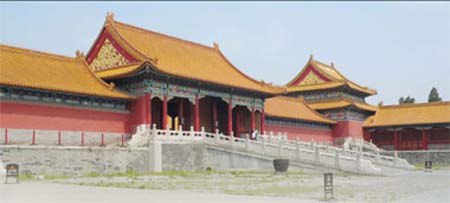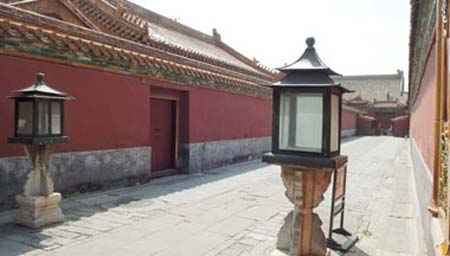Forbidden City -- high-tech city
|
|
|
Buildings attached to Taihe Hall (Hall of Supreme Harmony), which is the largest in the Forbidden City.[Photo Source: Shanghai Daily/by Lucia Wang] |
China's 600-year-old Forbidden City is renovating its Website in a move to enhance its offerings of Chinese culture.
Hu Chui, head of the Palace Museum's information department, says the new version is scheduled to launch during the National Day holiday in early October.
"It will give visitors richer and easier access to the imperial city, an ancient building complex with as many as 8,707 rooms and 1.5 million artistic articles," says Hu.
The Forbidden City is the world's largest surviving imperial palace complex and served as the home of the emperor and his household, as well as being the ceremonial and political center of the Chinese government from 1420 to the early 20th century.
|
|
|
Eave of the Jingyang Palace[Photo Source: Shanghai Daily] |
The new Website is restructured to meet the different demands of visitors, either as a layman or an expert, Hu says.
There will be quizzes, teaching basic knowledge about ancient China, suitable for children. The museum has also created a cartoon figure as its image ambassador, a young emperor clad in a bright yellow royal robe adapted from Emperor Kangxi, one of the most famous emperors of the Qing Dynasty (1644-1911).
Older visitors can expect tens of thousands of pictures of good quality with detailed descriptions.
Hu's 60-strong team are also producing seven 3D documentaries, each of them a 20 to 30-minute film with real scenes and special effects produced by computer.
A yet-to-open 3D cinema is in the southwestern corner hall in the yard of Taihe Hall (Hall of Supreme Harmony), with black walls and red chairs.
Xu Ying, director of the museum's exhibition technology section, says the cinema is a removable steel structure that minimizes any possible damage to the ancient wood architecture of the hall.
|
|
|
Interior of Baohe Hall, which occupies 1,240 square meters.[Photo Source: Shanghai Daily] |
"Unlike the ordinary museums, the wood construction of the building is the exhibit itself. The preservation is as important as the exhibition," says Qi Xin, a technician with Hu's team.
Since April, visitors have been able to use electronic touch screens to scan details of ancient calligraphy works and paintings in the imperial collections at an exhibition in the Hall of Martial Valor in the southwestern part of the palace.
On the screens, beside every exhibit, one can find detailed descriptions and be able to zoom in on high-definition pictures.
"It's wonderful. I could see much clearer via this than pressing my face onto the glass around the exhibits," says Chen, a college sophomore from Jiangsu Province. "This is what a museum should be."
The Forbidden City was listed as a World Heritage Site in 1987 by UNESCO with the largest collection of preserved ancient wooden structures in the world.
Despite more than 8 million visitors annually, knowledge of its architecture and antique collections is often limited. Many visitors come here only to boast that they have been in the emperor's bedroom.
|
|
|
Corridor between palaces of imperial concubines[Photo Source: Shanghai Daily] |
"That's why we are committed to digital technology. It could make learning more attractive," says Hu.
Currently, about 200,000 users have registered in the museum's "Virtual Forbidden City" online travel community or "Beyond Time and Space," which kicked off last October jointly with IT giant IBM.
A click on the mouse, and you can take a three-dimensional tour of the 725,000-square-meter museum.
However, despite the many registrations, the number of users is declining.
"It really attracted me at first. But the content is limited. A tour takes just 15 minutes," says Yang Shuo, a 25-year-old user.
Other users complain scenes are slow to change during the 3D tour.
Guo Weide, of the IBM China Group, says: "We hope to make further developments together with the museum."
IBM produced a similar online museum "Eternal Egypt" based on Egypt's pyramids.
"I'm sure the new Website could make up its shortcomings," says Hu. "And after all, the digital technology is a supplementary tool that attracts and helps people to know."
Having taken pictures of items in the museum for 30 years, he says it was "a great pity" that so many valuable artifacts were unknown throughout the world.
 0 Comments
0 Comments











Comments